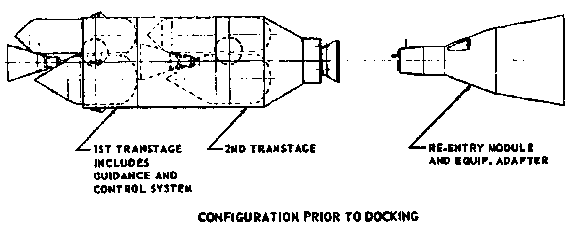
Home - Search - Browse - Alphabetic Index: 0- 1- 2- 3- 4- 5- 6- 7- 8- 9
A- B- C- D- E- F- G- H- I- J- K- L- M- N- O- P- Q- R- S- T- U- V- W- X- Y- Z
Gemini - Double Transtage

Gemini/Transtage-LEO
Translunar Gemini with Double Transtage - LEO Configuration
Credit: © Mark Wade
Status: Study 1965. Thrust: 71.17 kN (15,999 lbf). Gross mass: 15,200 kg (33,500 lb). Unfuelled mass: 4,600 kg (10,100 lb). Specific impulse: 311 s. Height: 11.70 m (38.30 ft).
Discretely called 'Gemini - Large Earth Orbit', the plan would use a Titan 3C-launched Transtage to boost the Gemini to translunar speed.
A declassified memorandum from the Director, Gemini Systems Engineering, documents a June 24, 1965 meeting at Manned Spaceflight Center between the contractors' corporate heads and highest NASA management. At this meeting the companies provided a detailed proposal to launch a refurbished, modified Gemini around the moon by April 1967 for $ 350 million. The Gemini would have 521 kg of mass deleted, half of it by removing the solid fuel retrograde rockets used to initiate re-entry (the liquid fuel Orbital Maneuvering System would be reengineered to increase its reliability). The Titan 2-launched Gemini would rendezvous and dock with a Titan 3C-launched 'Double Transtage'. The Double Transtage consisted of an unmodified first Transtage that would place itself and a second Transtage into low earth orbit. The first Transtage retained the navigation and maneuvering systems necessary to move the assembly to the rendezvous orbit with Gemini. The second Transtage would be stripped of unnecessary equipment (the orbital maneuvering system) but was equipped with an Agena-type docking collar.
After docking with the Double Transtage, the first Transtage would be cast off and the second Transtage would propel the Gemini into a circumlunar trajectory. The flights themselves, assuming go-ahead was given in September 1965, would follow immediately after the last Gemini flight. In December 1966 a Titan 3C would drive a 2450 kg circumlunar Gemini capsule to 11 m/s re-entry velocity to verify the heat shield design. This would be followed by a February 1967 manned qualification flight in earth orbit. A manned Gemini would dock with a Double Transtage and be propelled into a high orbit and re-entry speed. In April the sequence would be repeated, this time the Gemini being sent by Transtage into a loop around the moon.
The author of the memo thought that Gemini extension efforts would be better directed towards proving space station assembly techniques and procedures using Gemini and Agena. He also thought the schedule and cost estimates to be over-optimistic. The reaction of top NASA management was more categorical. Pete Conrad managed to stir Congressional interest, but NASA administrator James Webb informed them that any extra funds Congress cared to appropriate for such a project would be better spent accelerating the Apollo program. After further internal struggles, Conrad finally got NASA approval for the Agena on his Gemini 11 flight to boost him into a record 1,570 km orbit. This high flight was the only remnant of lunar Gemini.
Crew Size: 2. Habitable Volume: 2.55 m3. Spacecraft delta v: 3,600 m/s (11,800 ft/sec). Electric System: 150.00 kWh. Electric System: 2.20 average kW.
Family: Lunar Orbiters, Manned Circumlunar, Moon. People: McDonnell. Country: USA. Launch Vehicles: Titan. Propellants: N2O4/UDMH. Agency: NASA. Bibliography: 205.
1965 June 24 - .
- Proposal to launch Gemini around the moon - .
Nation: USA.
Spacecraft Bus: Gemini.
Spacecraft: Gemini - Double Transtage.
Gemini contractors proposed to launch a refurbished, modified Gemini around the moon by April 1967 for $ 350 million. The Titan 2-launched Gemini would rendezvous and dock with a Titan 3C-launched 'Double Transtage', which would propel the Gemini into a circumlunar trajectory. McDonnell-Douglas and Martin Marrietta's proposal was suppressed by NASA as a threat to the Apollo program.
Back to top of page
Home - Search - Browse - Alphabetic Index: 0- 1- 2- 3- 4- 5- 6- 7- 8- 9
A- B- C- D- E- F- G- H- I- J- K- L- M- N- O- P- Q- R- S- T- U- V- W- X- Y- Z
© 1997-2019 Mark Wade - Contact
© / Conditions for Use